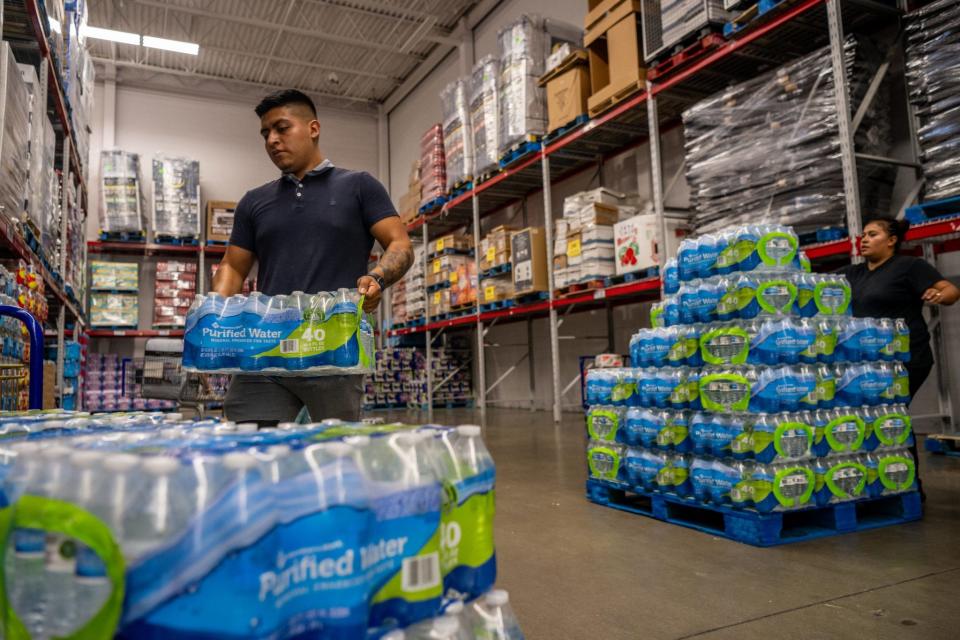Sam’s Club is going after Costco through the hearts and wallets of Gen Z shoppers. ‘That generation believes it’s cool to save money,’ CEO says

Gen Z is growing up and opening their wallets—to the tune of $360 billion in spending power in the U.S. alone—and members-only big-box retailers are ready to devour their dollars. Sam’s Club, the Walmart-owned membership-only warehouse store, believes it has cracked the code to winning over the young generation and hold the advantage over competitors like cult favorite Costco.
Sam’s Club CEO Chris Nicholas told CNBC in an interview last week that company membership has been transformed by young shoppers. In the past two years, Sam’s Club saw a 68% growth in Gen Z members.
“The quickest growth in our business over the last two years has been the Gen Z and millennial members,” Nicholas said. “That generation believes it’s cool to save money, and we agree with them.”
Gen Z’s bitter attitude toward the economy and strong desire to save have made them perfect candidates for discount retailers. The generation approaching their late twenties are leading the trend in preferring private-brand products, with 64% of young shoppers saying they buy private brands “always/frequently,” according to a November 2023 Private Label Manufacturers Association survey of 934 respondents. Amid steep inflation, retailers like Target and Walmart are responding by increasing their selection of own-brand items, including Walmart’s relaunched fashion brand and its new grocery line favoring plant-based items in colorful packaging.
But while everyone is focused on value, Nicholas argued, Sam’s Club has been able to differentiate itself through digital innovation that's refreshing to the tech-savvy youth. The retailer ramped up its e-commerce operations last year by expanding its warehouse facilities and supply-chain networks. It doubled down on technology by announcing in January the use of AI in its Scan & Go app, allowing customers to cut exit lines by confirming they’ve paid for all items in their shopping carts with a computerized scanning tool. The app is being used by 30% of Sam’s Club members, Nicholas said.
“We’re going on a journey of saying, ‘You can have great items, great prices like the rest of the club channel, but you can also have convenience,’” Nicholas said. “And that’s something that really is resonating.”
The big-box brawl for Gen Z’s attention
While Sam’s Club has been able to curry Gen Z’s favor with technology that simplifies the shopping process, Costco still relies on its idiosyncratic organization that can be intimidating for new shoppers, Zak Stambor, senior analyst of retail and e-commerce at Emarketer, told Fortune.
“The people I know who shop at Costco frequently, they have the Costco experience down pat, but there's a learning curve to that,” he said.
Costco customers not only have to familiarize themselves with the store’s haphazard shelving categories (though it’s a strategy proven partially beneficial because it tricks shoppers into buying more), they must also figure out the best hours to visit to avoid crowds. That’s not to mention its largely analog checkout operations, which require workers to manually look over customers’ purchases, which often requires shoppers to wait in lines to leave the store. Those are problems Sam’s Club customers don’t really have.
“It's more about making it easy to shop, and that's the advantage that [Sam’s Club] found,” Stambor said. “If you shop at Costco, it can be a frustrating experience.”
But Costco has been masterful at creating a near-pristine reputation for its Kirkland Signature private brand, Stambor argued. That, along with its mainstay strategies like good service and products with strong value, prompted UBS analyst Michael Lasser to call Costco shoppers the most loyal customers among retailers. Sam’s Club has mimicked Costco’s strategy in its own expansion of own-brand Member’s Mark. The company enlisted 50,000 of its customers this month to generate ideas for and evaluate new items under the brand.
“The private label piece is the critical ingredient here in the formula for success,” Stambor said. “Consumers, over the past few years in the wake of rising prices, have been far more willing to trade down to store brands.”
Everyone’s a winner
This is a big moment for these two members-only retailers, Stambor argued. Both had recent blockbuster earnings, with Costco reporting 9.1% net sales increase to $57.39 billion in its first quarter, and Sam’s Club seeing a 4.6% first-quarter net sales increase from the year before, helping Walmart achieve 6% revenue growth. And because consumers have been particularly sensitive to prices, they are willing to shake up old loyalties in search of new ones, creating more opportunities for new membership.
“When consumers are focused on value, their habits change, and that's when these types of members-only clubs can move in and help consumers establish new habits and new behaviors,” he said.
While Sam’s Club may have an advantage in Gen Z customers right now, Costco, with a long-trusted private brand and buzzy products like its newly launched Kirkland Signature apparel, still has the chance to usher in waves of new shoppers.
“Both members’ clubs have an opportunity to wave their arms and say, ‘Hey, younger consumers, if you want value, we offer value,’” Stambor said.
This story was originally featured on Fortune.com

 Yahoo Finance
Yahoo Finance 